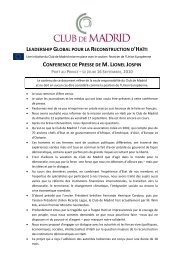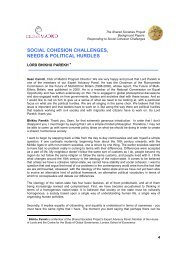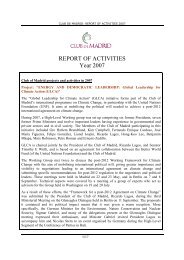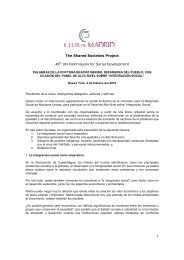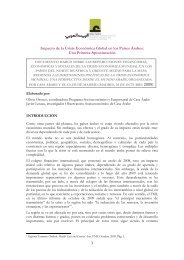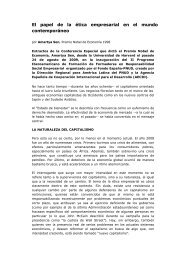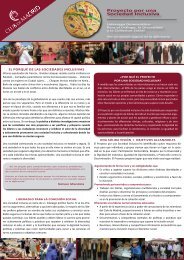Investing cultural diversity and intercultural dialogue - Business and ...
Investing cultural diversity and intercultural dialogue - Business and ...
Investing cultural diversity and intercultural dialogue - Business and ...
Create successful ePaper yourself
Turn your PDF publications into a flip-book with our unique Google optimized e-Paper software.
8 . PART I – CULTURAL DIVERSITY: WHAT IS AT STAKE?<br />
L A beggar passing a street<br />
advertisement in Athens,<br />
Greece<br />
Regional <strong>and</strong> international initiatives<br />
In a world marked increasingly by the intermingling of<br />
cultures, efforts to safeguard the manifestations of<br />
<strong>cultural</strong> <strong>diversity</strong> assume particular importance for<br />
national governments as well as for the international<br />
community. In domains as varied as tangible heritage,<br />
intangible heritage, <strong>cultural</strong> expressions, <strong>cultural</strong><br />
exchanges <strong>and</strong> the illicit traffic in <strong>cultural</strong> goods, the<br />
agreements <strong>and</strong> st<strong>and</strong>ard-setting activities at regional<br />
<strong>and</strong> international levels have sought to protect <strong>and</strong><br />
promote some of the key tokens of <strong>cultural</strong> <strong>diversity</strong> <strong>and</strong><br />
markers of <strong>cultural</strong> identity. UNESCO, in keeping with its<br />
m<strong>and</strong>ate within the UN, has played a leading role in the<br />
formulation, promotion <strong>and</strong> implementation of many of<br />
these normative <strong>and</strong> other instruments.<br />
The development that leads from the 1954 Hague<br />
Convention for the Protection of Cultural Property in the<br />
Event of Armed Conflict, through the 1970 Convention on<br />
the Means of Prohibiting <strong>and</strong> Preventing the Illicit Import,<br />
Export <strong>and</strong> Transfer of Ownership of Cultural Property, the<br />
1972 Convention Concerning the Protection of the World<br />
Cultural <strong>and</strong> Natural Heritage, <strong>and</strong> the 2001 Convention on<br />
the Protection of the Underwater Cultural Heritage to the<br />
Culture refers both to the creative <strong>diversity</strong> embodied in particular<br />
‘cultures’ <strong>and</strong> to the creative impulse at the heart of that <strong>diversity</strong><br />
of ‘cultures’<br />
2003 Convention for the Safeguarding of the Intangible<br />
Cultural Heritage reflects a progressive extension of the<br />
concept of <strong>cultural</strong> heritage, increasingly understood to<br />
include not only the material expressions of the world’s<br />
diverse cultures but also their intangible manifestations,<br />
including oral traditions, performing arts <strong>and</strong> traditional<br />
know-how. In parallel, there has been a shift of emphasis<br />
from an implicit ranking of World Heritage sites (deemed<br />
‘of outst<strong>and</strong>ing universal value’) to a concern for<br />
highlighting exemplars of the intangible heritage that<br />
provide its repositories with a sense of identity <strong>and</strong><br />
continuity. The development reflects a dual movement:<br />
one leads to the recognition of a ‘common heritage’ that<br />
the international community has a duty to safeguard as<br />
the expression of a common human inheritance; the<br />
other leads to the recognition of the specificities of<br />
cultures, which, though they may be fluctuating <strong>and</strong><br />
transitory in nature, must be valued <strong>and</strong> recognized in<br />
their own right.<br />
A new era has begun in the exploration of the concept<br />
of <strong>cultural</strong> <strong>diversity</strong> with the adoption in 2001 of the<br />
Universal Declaration on Cultural Diversity <strong>and</strong> in 2005 of<br />
the complementary Convention on the Protection <strong>and</strong><br />
Promotion of the Diversity of Cultural Expressions. In<br />
addressing the exchanges between the cultures that<br />
constitute our universal heritage, the 2005 Convention<br />
aims to preserve the specificities of cultures while<br />
promoting their development on a global scale through<br />
interaction <strong>and</strong> commercialization.<br />
Indeed, culture has two meanings, which are different<br />
yet wholly complementary. Firstly, culture is the creative<br />
<strong>diversity</strong> embodied in particular ‘cultures’, with their<br />
unique traditions <strong>and</strong> tangible <strong>and</strong> intangible<br />
expressions. Secondly, culture (in the singular) refers to<br />
the creative impulse at the heart of that <strong>diversity</strong> of<br />
‘cultures’. These two meanings of culture – one selfreferential,<br />
the other self-transcending – are inextricably<br />
linked <strong>and</strong> provide the key to the fruitful interaction of all<br />
peoples in the context of globalization.<br />
J African immigrants<br />
queue at the port of<br />
Lampedusa before being<br />
transferred to Sicily, Italy



